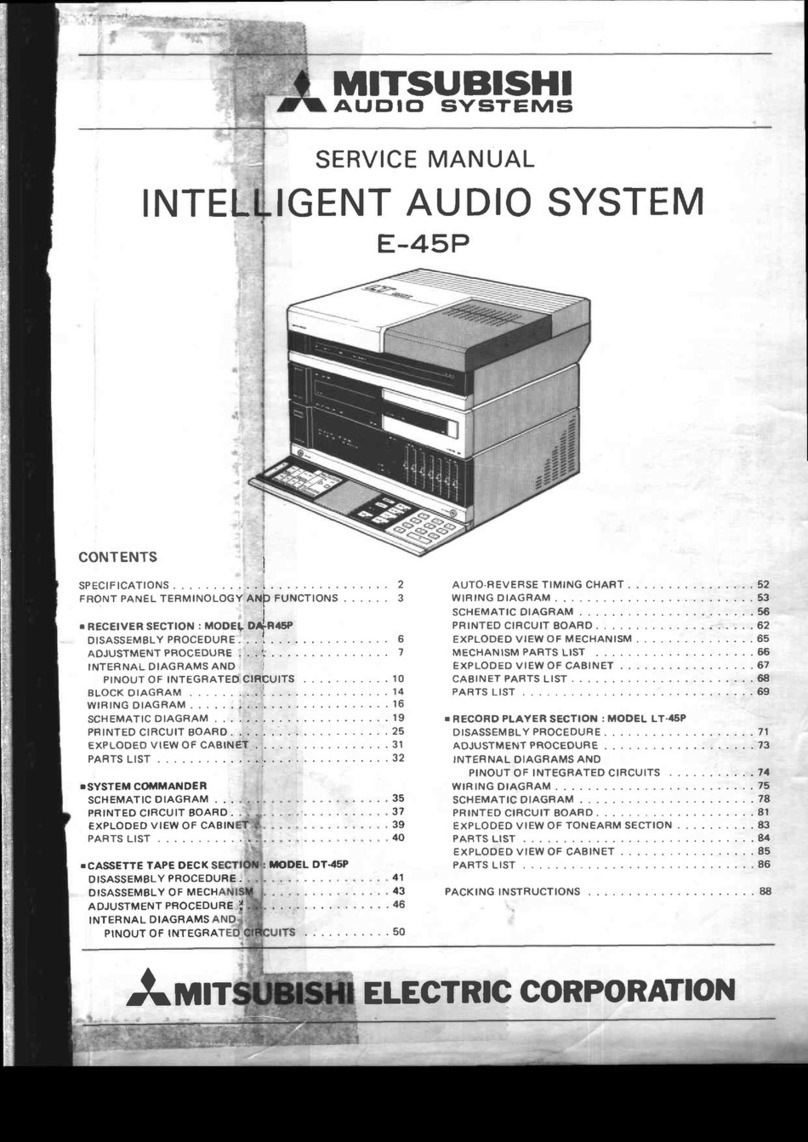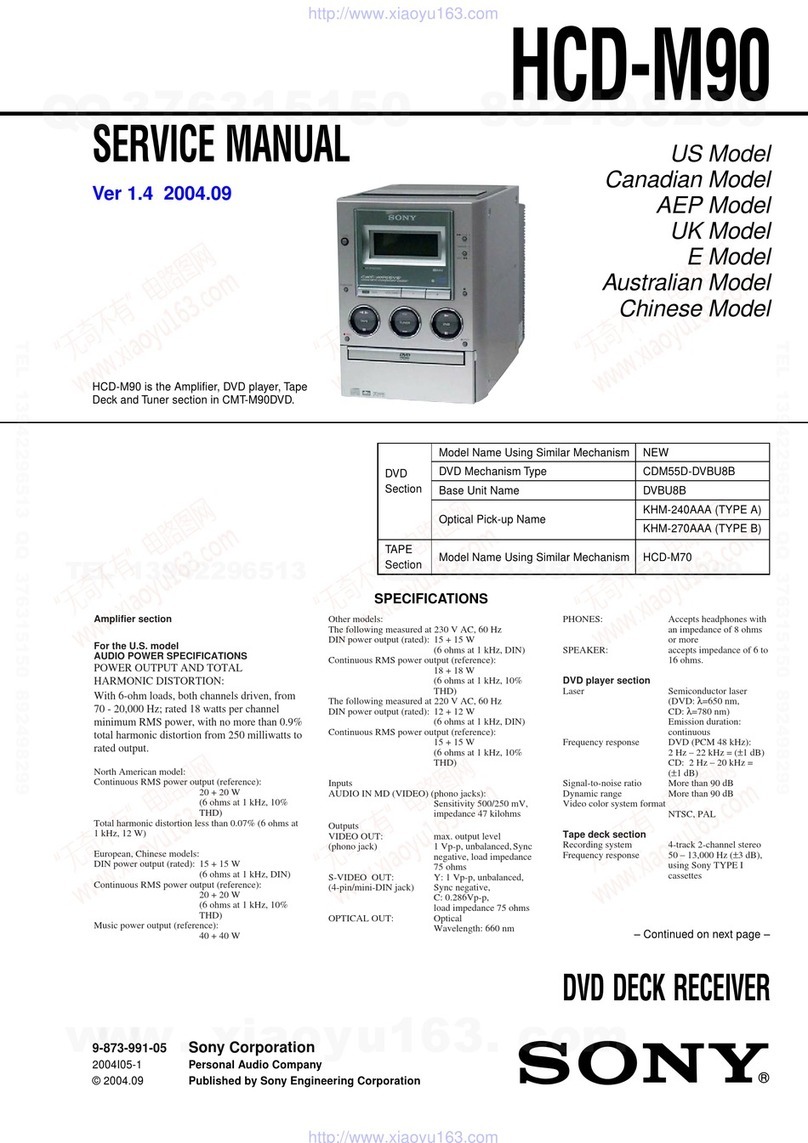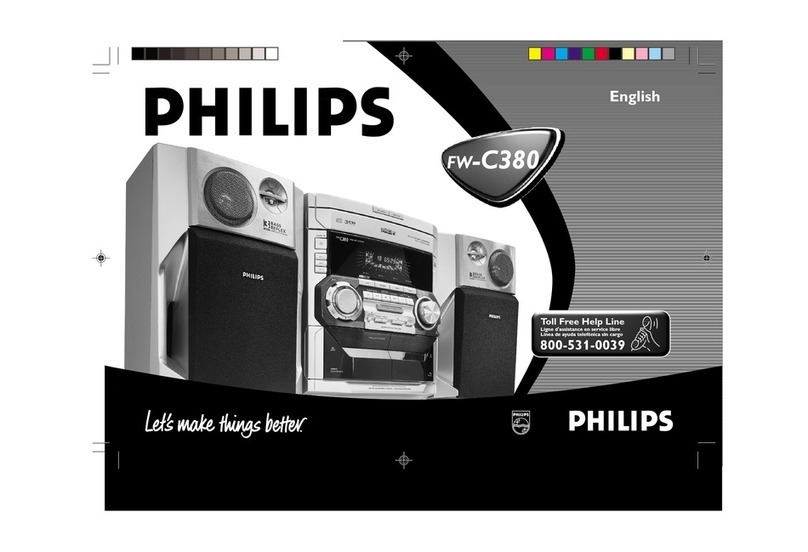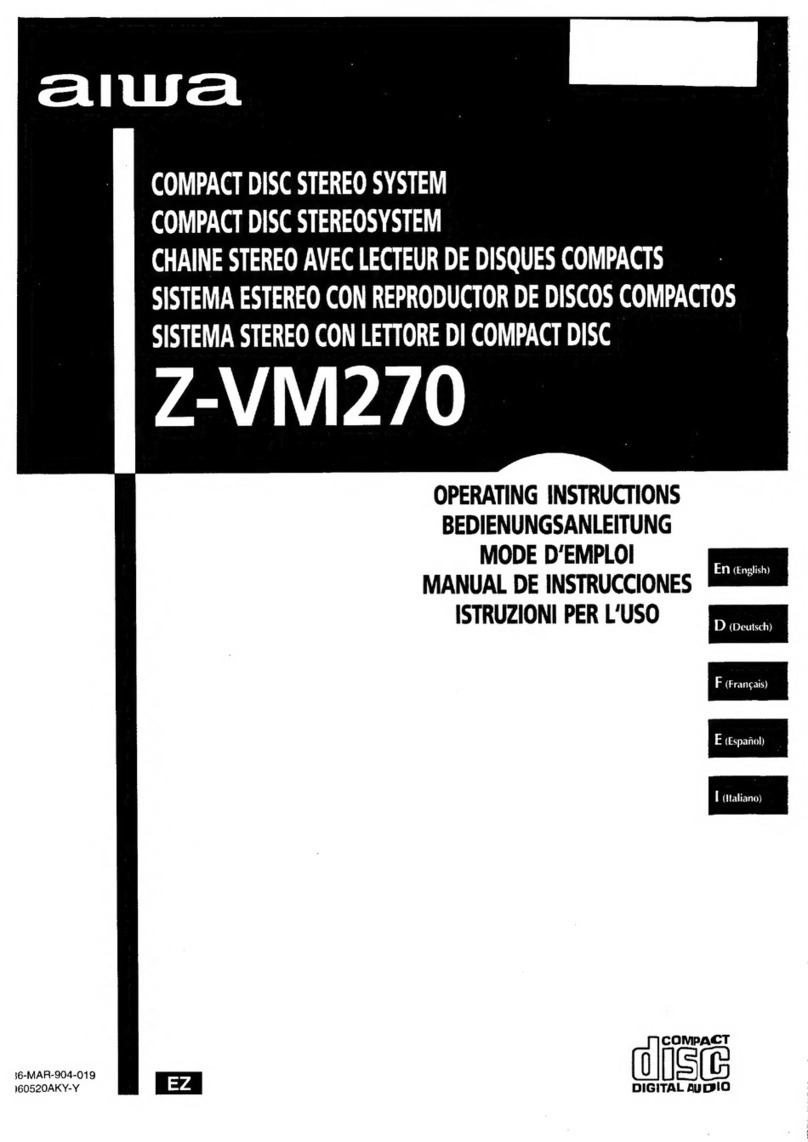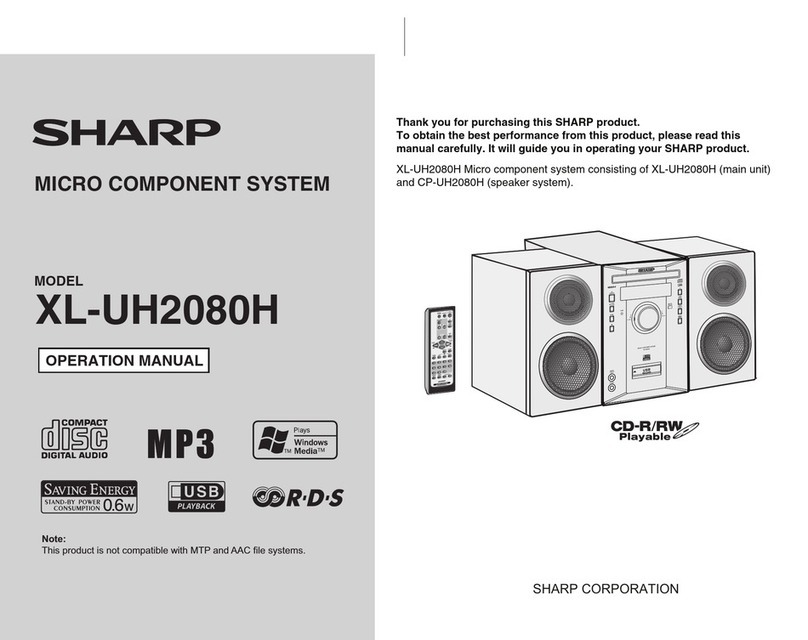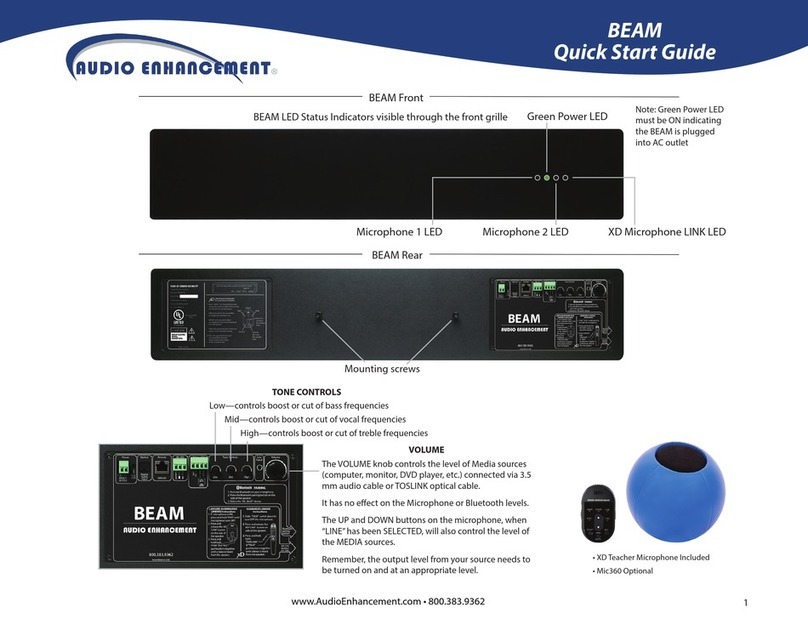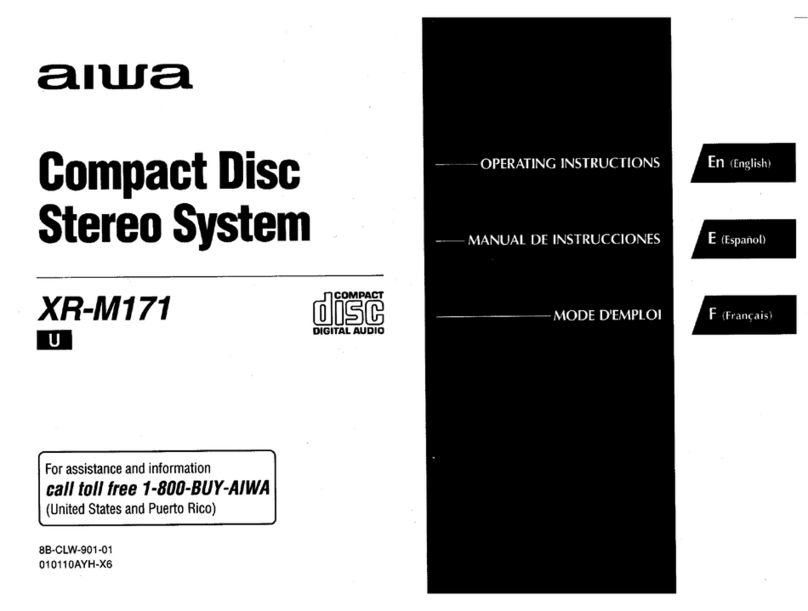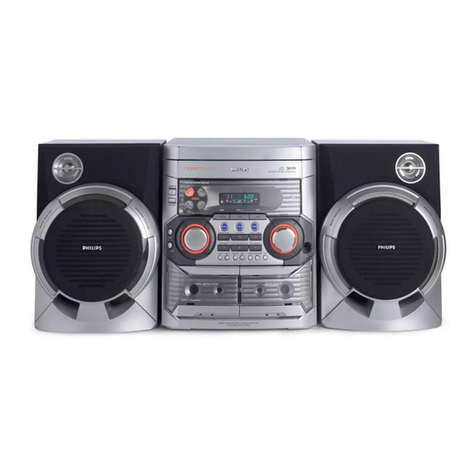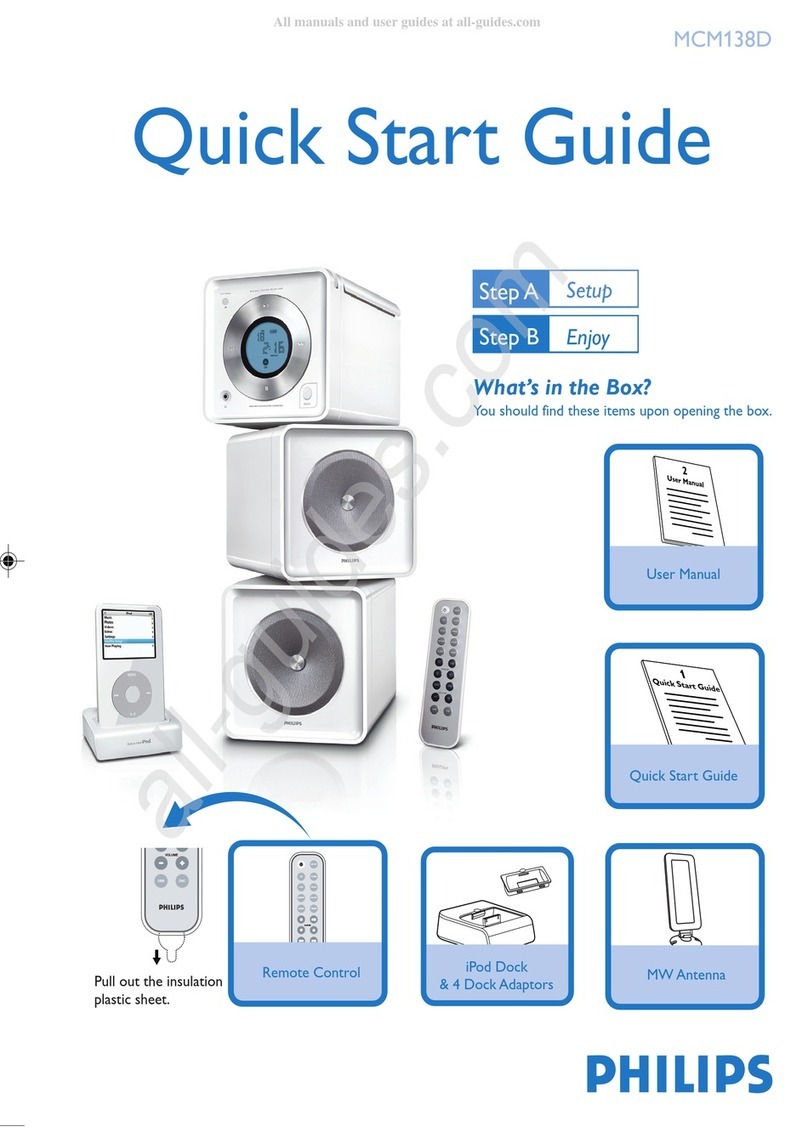Mitsubishi Z-20 User manual

a’.
MITSUBISHI
MULTIPLAY
SYSTEM/INTELLIGENT
AUDIO
SYSTEM
=
MODEL
2-20
INSTRUCTION
BOOK/NOTICE
D'UTILISATION
Congratulations
on
your
choice
of
the
Mitsubishi
Multiplay
System/Intelligent
Audio
System
Model
Z-20.
For
the
best
performance
results,
please
read
this
instruction
book
carefully
before
use.
WARNING—TO
PREVENT
FIRE
OR
SHOCK
HAZARD,
DO
NOT
EXPOSE
THIS
APPLIANCE
TO
RAIN
OR
MOISTURE.
For
future
reference
a
space
has
been
provided
below
for
the
recording
the
serial
number
of
your
audio
system
model
2-20.
Serial
No.
Enhorabuena
por
haber
seleccionado
el
sistema
de
reproduccién
multiple/systema
inteligente
de
audio
Z-20
de
Mitsubishi.
Para
obtener
el
mejor
rendimiento
posible,
lea
aten-
tamente
este
manual
de
instrucciones
antes
de
poner
el
aparato
en
funcionamiento.
AVISO—PARA
EVITAR
INCENDIOS
Y
DESCAR-
GAS
ELECTRICAS,
NO
EXPONER
ESTE
APARA-
TO
ALALLUVIA
NI
A
LA
HUMEDAD.
Para
futuras
referencias,
se
ha
dejado
un
espacio
en
blanco
abajo
para
anotar
el
nimero
de
serie
de
su
systema
de
audio
modelo
2-20.
N°
de
serie
Wir
begliickwiinschen
Sie
zum
Kauf
des
Mitsubishi
Multiplay
System/Intelligentes
Audio-System
Modell
Z-20.
Bitte lesen
Sie
diese
Bedienungsanleitung
vor
der
Benutzung
des
Gerates
sorgfaltig
durch,
damit
sie
in
den
Genuf®
seiner
vollen
Leistung
kommen.
WORSICHT:
WEGEN
DER
GEFAHR
VON
FEUER
ODER
ELEKTRISCHEN
SCHLAGEN
IST
DAS
GERAT
VOR
REGEN
UND
FEUCHTIGKEIT
ZU
SCHUTZEN.
Tragen
Sie
bitte
die
Seriennummer
Ihres
Gerates
in
das
frei-
gelassene
Kastchen
unten
ein,
damit
Sie
spater
leicht
darauf
zuriickgreifen
k6nnen.
Seriennummer
Hartelijk
dank
voor
de
aanschaf
van
dit
Mitsubishi
multiplay
intelligent
audio-system
Z-20.
Lees
de
gebruiksaanwijzing
aandachtig
door
alvorens
het
apparaat
in
gebruik
te
nemen.
WAARSCHUWING—STEL
HET
APPARAAT
NIET
BLOOT
AAN
REGEN
OF
VOCHT
OM
BRAND
OF
EEN
GEVAARLIJKE
ELECTRISCHE
SCHOK
TE
VOORKOMEN.
Noteer
in
het
onderstaande
vakje
het
serienummer
van
uw
audio
system
model
Z-20.
Dit
nummer
heeft
u
naderhand
misschien
nodig..
Serienummer:
Vous
étes
devenu
[’heureux
propriétaire
SYSTEME
MULTIPLAY/SYSTEME
AUDIO
INTELLIGENT
“Mitsubishi
Z-20’’
et
nous
vous
en
félicitons.
Veuil-
lez
lire
attentivement
cette
notice
d'utilisation,
avant
d’emploi
de
cet
ensemble
stéréophonique
de
haute
qualité,
pour
que
vous
puissiez
jouir
pleine-
ment
de
ses
performances.
ATTENTION:
EN
RAISON
DU
DANGER
‘D’'IN-
CENDIE
OU
DE
DECHARGES
ELECTRIQUES,
IL
FAUT
PROTEGER
L’APPAREIL
CONTRE
LA
PLUIE
ET
L’HUMIDITE.
Inscrivez
le
numéro
de
série
de
systéme
autio
modéle
Z-20
dans
ta
case
libre
ci-dessous,
de
maniére
a
ne
pas
|’oublier,
par
la
suite.
Numéro
de
série
Vi
gratulerar
dig
till
valet
av
Mitsubishis
Flerkompo-
nents
m&ngsidiga
musiksystem/Logiska
programmer-
bara
|judsystem
Modell
2-20.
Studera
denna
bruksanvisning
noga
innan
apparaten
tas
i
bruk,
s&
att
du
helt
kan
utnyttja
alla
dess
finesser.
VARNING:
FOR
ATT
UNDVIKA
BRANDFARA
ELLER
ELEKTRISKA
OVERSLAG
SKALL
APPA-
RATEN
SKYDDAS
FOR
FUKT
OCH
VATA.
Notera
garna
apparatens
serienummer
i
den
fria
rutan,
s&
har
du
den
1att
till
hands
vid
framtida
behov.
Serienr:

Connect
the
speakers
and
antennas
as
illustrated
below.
Be
sure
to
switch
OFF
the
POWER
supply
before
you
con-
nect
these.
After
completing
their
connection,
check
that
the
VOLUME
knob
has
been
turned
down
to
its
lowest
setting
(0)
before
you
attempt
to
switch
the
POWER
back
ON
again.
Raccorder
I’enceinte
(ou
les
enceintes)
et
|‘'antenne
comme
le
re-
présente
I'iflustration
ci-dessous.
Avant
de
ies
raccorder,
placer
la
touche
d’alimentation
(POWER)
sur
OFF.
Aprés
avoir
terminé
les
raccordements,
s‘assurer
que
le
bouton
de
VOLUME
a
été
régié
sur
la
position
minimum
(0)
avant
de
remettre
la
touche
d’alimentation
(POWER)
sur
ON.
[
External
Tape
Deck
Enregistreur
a
cassette
ext.
Mount
to
a
post
or
wall
(etc).
te
monter
sur
un
pitier,
un
mur
etc,
Remove
the
/
double-face
tape
separator.
Retirer
le
sépara-
double
face.
du
ruban
tion.
AM
Loop
Antenna
The
unit
is
packed
with
the
AM
loop
antenna
taken
off
from
the
chassis.
Mount
the
holder
first
as
shown
in
the
illustration
and
then
connect
to
the
antenna
terminal.
To
receiving
AM
broadcasts,
select
the
desired
station
first
and
then
move
the
loop
antenna
in
the
appropriate
direction
and
position
to
achieve
optimum
7
acs
Look
for
a
posi-
tion
allowing
fa-
vorable
reception.
Rechercher
fa
Position
assurant
une
bonne
récep-
Loop
antenna
hoider
(Accessory)
Support
d‘an-
tenne
cadre
Antenne
cadre
AM
L'appareil
est
emballé
avec
l'antenne
cadre
AM
retirée
du
chassis.
Monter
tout
d'abord
le
support
comme
fe
représente
litlustration,
puis
la
rac-
corder
4
la
borne
d’antenne.
Pour
écouter
une
émission
AM,
choisir
tout
d’abord
la
station
désirée
et
déplacer
(’antenne
cadre
dans
fa
di-
rection
et
sur
la
position
assurant
tes
Compact
Disc
Player
etc.
Lecteur
de
Disque
Compact,
etc.
Look
for
a
posi-
tion
allowing
fa-
vorable
reception.
Rechercher
ta
po-
sition
assurant
la
meilleure
récep-
tion.
reception
conditions.
If
no
satisfactory
reception
can
be
Si
l'on
ne
peut
obtenir
une
bonne
obtained
while
attached
to
the
chas-
réception
avec
l’antenne
sur
le
chassis
sis,
peel
off
the
double-face
separator
et
s'il
n’y
a
pas
d'espace
derriére
on
the
loop
antenna
supplied
as
a
celui-ci,
retirer
le
séparateur
du
ruban
standard
accessory
to
allow
it
to
be
double-face
de
i‘antenne
cadre
fourni
used
mounted
to
a
post
or
wall
{etc.).
comme
accessoire
standard
et
monter
meilleures
conditions
de
réception.
Vantenne
sur
un
pilier,
un
mur
etc.
xternal
recording
|
putput
terminal
KREC
OUT)
Borne
de
sortie
d’en-
Speaker
system/Enceinte
acoustique
(Left
speaker)
{Right
speaker)
(Enceinte
gauche}
(Enceinte
droite}
|
TT
[After
compieteing
all
connections,
insert
plug
into
the
POWER
socket.
ents,
brancher
la
fiche
dans
la
=
NaN
AHI
eee
sils——\,
Bornes
d‘ens
Bornes
d'enceintes
B
Wt
bssnnancancevsecveaiiny
UT}
CUAANUUAL
ELI
HEULTATUT
ETE
TT
prise
d’alimentation
(POWER).
AUXILIARY
MEMORY
BACKUP
BATTERIES
©
These
batteries
are
used
to
ensure
the
tuner
presetting
and
functions
are
stored
in
the
even
when
the
POWER
supply
has
been
cut
off.
:
When
inserting
the
batteries
supplied
as
accessory
parts,
be
sure
to
align
their
polarities
(+)
(--)
correctly.
@
The
batteries
last
for
more
than
a
year.
{The
built-in
capaci-
tor
will
provide
a
memory
backup
for
12
hours
or
more
even
without
the
batteries.}
@
When
the
power
supply
from
the
batteries
fails,
the
tuner
FM
presettings
will
alt
become
87.5
MHz.
PILES
DE
PROTECTION
DE
LA
MEMOIRE
AUXILIAIRE
Ces
piles
empéchent
que
les
données
des
préréglages
du
tuner
et
des
fonctions
en
mémoire
ne
soient
effacées
en
cas
de
coupure
de
i’alimentation.
Lors
de
la
mise
en
place
des
piles
fournies
comme
accessoires,
aligner
correctement
leurs
polarités
(+)
{—).
Les
piles
durent
plus
d’une
année.
{Le
condensateur
incorpo-
ré
protége
la
mémoire
pendant
au
moins
12
heures
méme
sans
piles.)
Lorsque
les
piles
sont
déchargées,
les
prérégiages
FM
du
tuner
deviennent
tous
87.5
MHz.
Outdoor
AM
Antenna
Antenne
AM
extérieure
Se
en
ee
aes
to
AM
ANT.
terminal
Borne
de
I’antenne
AM
@Remain
AM
Loop
Antenna
connected
when
applying
out-
door
AM
antenna,
@Déconnecter
‘antenne
AM
intérieure
si
vous
utilisez
une
antenne
ex
térieure,
Outdoor
FM
Antenna
Antenne
MF
extérieure
75
ohms
coaxial
cable
300
ohms
T+
fiat
twin-lead
i
Antenne
plate
Antenne
co-
300
ohms
|
axiale
75
ohms
Ae
Supplied
“T-shaped”
Antenna
Antenne
d’intérieure
fournie
FM
antenna
supplied
with
this
unit.
Antenne
MF.
fournie
avec
Vappareil.
GND
(Ground
terminal)
(Branchement
>
Copper
plate
°%°
or
carbon
rod
Fig.
7
Pinch
roller
Gelet-presseur
Fig.
1
Capstan
Cabestan
Vis
de
fixation
pour
transport
Binder
Verrouillage
du
bras
Fig.
3

sina
atta
tet
A
ae
A
ll
rie
Fixing
nut
for
platter
Loosen
J
nut
f
a
/
-
lateau
Relacher
f
Serre-joint
a
platea
aad
A
\
Tige
centrale
Align
the
wrench
with
Serrer
the
key
slots
of
the
unit.
Aligner
la
clef
sur
la
serrure
du
corp,
Fig,
4
Center
shaft
Vis
central
i
Wrench
Clef
\
Fixing
nut
for
platter
Platter
Serre-joint
a
Plateau
plateau
Barre
;
Fig.
5
Fig.
6
25
28
27:
26
32 30
29
46
41
at
|_|
ln
een
reree
nee
a
=
Sa
A
CA
FC
RS!
oC
TE
Se
REee
2345
6
7
|47
9 8
10;12
11
13 31
1516
17
18
42
43
44
45
Fig.
8
39
14
|
19
20
21
22
23
24

VOLUME
Fig.
9
Fig.
10
_—”
PHONES
Fig,
11
|
FUNCTION
|
|
|
cosaux
|
orm
|
MW
[lw
et
TAPE
|
Fig.
12
VOLUME
TREBLE
Fig.
13
Fig.
14
FUNCTION
i]
tw
|
PHONO
[TAPE
|
Fig.
15
VOLUME
o
10
ee
BALANCE
t
R
eas
Fig.
21
Fig.
17
Fig.
22
DOLBY
NR
off
lL
Fig.
18
Fig.
23

FUNCTION
mw
|
LW
|
PHONO
[TAPE
|
CD/AUX
Fig.
24
VOLUME
2
10
a
A
eee
Fig.
25
ACCESS
(
<@)
MANUAL)
o>
)
Fig.
26
For
side
B
;
Sur
le
c6té
B
For
side
A
’
Sur
le
cote
A
.
Fig.
27
Adhesive
Tape
Ruban
Adhesif
Fig.
28
Audio
Timer
Audio
Chronorupteur
Fig.
29
MIC
Fig.
30
MIXING
source
mic
Fig.
31
ON
Sous
tension
ez
Fig.
32
REC
CONTROL
{
ec
|
REC
MU
SPEED
|
REC
has
PAUSE
Fig.
33
MIC
Fig.
34
cD/AUX
|
FM
of.
MW
of
LW]
PHONO
[TAPE
MIXING
source
mic
Fig.
36
REC
CONTROL
speD
|
REC
|
rec
|
PAUSE
thas,
Fig.
37

ENGLISH
PRECAUTIONS
1.
GENERAL
Be
sure
to
use
the
correct
A.C.
power
source.
Do
not
plug
in
or
unplug
the
power
cord
with
wet
hands.
e@
Handie
the
power
cord
with
care.
Do
not
remove
the
power
plug
by
pulling
on
the
power
cord.
If
the
insulation
becomes
damaged,
the
conductor
breaks,
or
poor
contacts
occur,
request
service
from
your
authorized
service
dealer.
@
Do
not
touch
the
inside
of
this
unit
or
remove
the
rear
panel,
@
Disconnect
the
power
cord
at
the
first
sign
of
trouble.
2.
LOCATION
@
This
unit
can
become
unstable
if
operated
in
extremely
high
or
low
temperatures.
Place
it
in
a
well
ventilated
area
for
correct
heat
dissipation.
Avoid
placing
in
direct
sunlight,
near
air
conditioners,
poorly
ventilated
areas
or
in
areas
of
excess
humidity
or
dust.
Do
not
block
the
ventilation
holes
in
the
cabinet.
@
Howling
sounds
(Acoustic
Feedback)
may
occur
if
this
unit
is
in
direct
contact
with
the
speakers.
Be
sure
to
leave
an
appropriate
space
between
the
speakers
and
the
side
of
this
unit.
3.
CONNECTIONS
e
Be
sure
to
turn
off
the
power
before
making
connec-
tions.
e
Use
extreme
care
in
making
the
correct
connections.
Reversing
the
R
(right)
or
L
(left)
speaker
leads
or
plus
(+)
and
minus
(—),
will
lead
to
poor
sound
quality.
@
Make
all
connections
securely.
e
Use
speakers
with
a
nominal
impedance
of
8
to
16
ohms.
(When
connecting
one
pair
of
speakers
connected
to
the
A
or
B
terminals).
@
When
using
two
pairs
of
speakers,
ensure
that
the
com-
bined
impedance
(both
pairs
of
speakers
operating)
is
8
ohms
or
above.
The
combined
impedance
is
determined
using
the
fol-
lowing
formula.
AxB
COMBINED
IMPEDANCE
=
i
=
(OHMS)
1OWAG:
<i
a
0.
=
g
16+
16
onms
A:
Nominal
impedance
of
speaker
A.
B:
Nominal
impedance
of
speaker
B.
@
Do
not
supply
excessive
input
to
the
speakers,
When
using
speakers
with
a
lower
power
handling
capacity
than
the
rated
output
power
of
this
unit
(20
W/ch),
avoid
excessive
volume
levels.
4.
OPERATION
e
Before
placing
the
power
switch
in
the
ON
or
OFF
posi-
tion,
always
set
the
volume
control
to
the
minimum
level.
@
Do
not
touch
the
turntable
platter
while
it
is
rotating.
@
Do
not
touch
the
tonearm
when
it’s
moving.
5.
CARE
@
Do
not
play
badly
soiled
discs.
e
Be
sure
to
close
the
dust
cover on
the
turntable
when
it
is
not
in
use.
6.
CASSETTE
DECK
MAINTENANCE
(1)
CLEANING
OF
HEADS
—:
Deposit
of
dust
and
dirt
cause
poor
contact
between
the
heads
and
tape
and
will
lead
to:
@
Deteriorating
tone
quality.
@
Reduced
volume.
e@
Failure
to
record.
e
Erratic
reproduction
of
sounds
(sounds
disappear
mo-
mentarily).
Failure
to
erase
previously
recorded
sounds.
Although
the
heads
should
be
cleaned
at
least
once
in
every
10
hours
use,
to
obtain
best
recording
and
playback
per-
formance,
it
is
recommended
to
be
cleaned
every
time
the
deck
is
used.
CLEANING
MATERIALS
Cotton
Q-tips,
or
a
soft
cloth
such
as
gauze
and
pure
alco-
hol
or
tape
head
cleaning
fluid.
PROCEDURE
1,
Push
to
open
the
cassette
holder.
2.
Remove
the
cassette
cover
as
shown.
(Fig.
1)
3.
Carefully:
wipe
all
tape-contacting
sections
as
the
heads,
pinch
roller
and
capstan.
(Fig.
2)
4.
Re-fit
the
outside
cover
to
its
original
position.
@
Do
not
insert
a
cassette
until
the
alcohol
has
completely
evaporated.
e
Another
cleaning
method
is
to
clean
by
itilizing
a
clean-
ing
tape.
In
this
case,
just
run
the
tape
through
once.
(2)
DEMAGNETIZING
THE
HEADS
The
heads
can
become
magnetized
after
long
periad
of
use.
This
can
cause
excessive
tape
hiss
and
a
foss
of
high
fre-
quencies.
The
heads
should
be
demagnetized
periodically
after
about
30
hours
of
playing
or
recording.
,
1.
Use
a
commercially
available
head-demagnetizer
accord-
ing
to
its
instructions.
Turn
off
the
power
switch.
Remove
the
cassette
cover.
Turn
on
the
power
to
the
head-
demagnetizer
and
bring
the
tip
of
the
head-demagnetizer
close
to
the
heads
and
capstan,
and
slowly
move
it
up
and
down
four
or
five
times.
5.
Slowly
remove
the
head-demagnetizer
from
the
heads
to
a
distance
of
more
than
30
cm
(12”)
and
switch
the
power
off.
6.
Attach
the
cassette
cover
again.
NOTE:
This
unit
requires
no
lubrication.
Lubrication
will
cause
malfunction,
and
may
cause
permanent
damage.
PON

ASSEMBLY
AND
CONNECTIONS
7.
CLEANING
THE
CABINET
When
dust
and
dirt,
etc.
are
deposited
on
the
surface,
wipe
off
using
a
soft,
dry
cloth.
Do
not
use
volatile
agents
such
as
alcohol,
thinner,
benzine,
or
insecticides
for
cleaning.
BE
SURE
TO
SET
THE
VOLUME
CONTROL
TO
A
LOW
VOLUME
POSITION
WHEN
THE
POWER
SWITCH
IS
TURNED
ON
OR
OFF,
OR
WHEN
CONNECTIONS
TO
THE
FRONT
OR
REAR
PANELS
ARE
MADE.
ASSEMBLY
AND
ADJUSTMENT
OF
TURNTABLE
BEFORE
ASSEMBLY
1.
Remove
the
fixing
screws
used
for
transport.
2.
Take
off
the
clamper
and
binder
used
for
fixing
the
tonearm.
(Fig.
3)
e
As
the
fixing
screws,
clamper
and
binder
are
needed
in
the
case
of
re-transport,
please
keep
them
safely.
MOUNTING
OF
PLATTER
1.
The
centre
shaft
is
provided
with
nut
to
fix
the
platter
in
place.
Using
the
supplied
wrench,
turn
the
nut
clock-
wise
and
take
it
off.
(The
centre
shaft
is
threaded
in-
versely.)
(Fig.
4)
2.
Insert
the
platter
into
the
centre
shaft.
Firmly
secure
the
platter
to
the
centre
shaft
by
turning
the
fixing
nut
counterclockwise.
(Fig.
5)
3.
Tighten
the
nut.
4.
At
the
time
of
repacking
the
unit,
the
platter
can
be
removed
by
manually
turning
it
with
the
supplied
shaft
inserted
into
the
centre
shaft
in
a
manner
for
the
platter
not
to
be
rotated.
(Fig.
6)
CONNECTIONS
(Fig.
7)
To
reduce
interference,
setting
should
be
made
away
from
the
TV
or
etc.,
as
possible.
FRONT
PANEL
FUNCTIONS
(Fig.
8)
1.
POWER
SWITCH
2.
CD/AUX
For
listening
to
an
external
unit
(additional
CD
player
or
TV
tuner,
for
example)
connected
to
the
‘‘CD/AUX"'
ter-
minals
on
the
rear
panel.
3.
FM
For
listening
to
FM
broadcasts,
depress
the
FM
button.
4,
MW
For
listening
to
MW
broadcasts,
depress
the
MW
button.
5.
LW
For
listening
to
LW
broadcasts,
depress
the
LW
button.
6.
PHONO
When
playing
a
record
with
the
turntable,
push
this
button.
The
tonearm
will
swing
over
to
the
outer
groove
of
the
record
and
commence
to
play.
7.
TAPE
When
playing
a
tape
with
the
cassette
deck,
push
this
button.
8.
(>)
AUTO
In
case
of
TUNER,
when
this
button
is
depressed,
the
recep-
tion
frequencies
are
swept
continuously
up
the
scale
until
a
frequency
of
a
station
actually
broadcasting
is
reached.
The
sweeping
then
stops
automatically.
in
case
of
TAPE,
when
this
button
is
depressed,
the
tape
will
fast
forward
wind
to
the
next
musical
number
and
restart
play
automatically.
9.
(<)
AUTO
In
case
of
TUNER,
when
this
button
is
depressed,
the
recep-
tion
frequencies
are
swept
continuously
down
the
scale
until
a
frequency
of
a
station
actually
broadcasting
is
reached.
The
sweeping
then
stops
automatically.
In
case
of
TAPE,
when
this
button
is
depressed,
the
tape
will
fast
rewind
to
the
edge
of
present
musical
number
and
re-
start
play
automatically.
10.
REPEAT
Depressed
when
the
disc
or
tape
is
to
be
repeatedly.
In
this
case,
the
repeat
indicator
is
illuminated.
11.
(»)
MANUAL
In
the
case
of
TUNER,
when
depressing
this
button,
the
reception
frequency
on
FM
changes
to
5O0kHz
and
on
AM
to
9KHz.
Keeping
this
button
depressed
causes
the
frequency
to
change
continuously
while
the
button
is
being
held
down,
Release
the
button
as
you
come
near
the
desired
frequency
and
select
the
final
frequency
by
pressing
the
button
once
at
a
time.
‘
In
case
of
TAPE,
when
this
button
is
depressed,
the
tape
will
fast
forward
wind.
For
restarting
the
play,
you
must
push
the
TAPE
button.
In
case
of
PHONO,
when
this
button
is
depressed,
it
will
cause
tonearm
to
be
moved
backward
the
edge
of
the
disc.
When
released,
the
tonearm
will
lower
onto
the
disc
and
start
to
play.
12.
(4)
MANUAL
in
case
of
TUNER,
when
this
button
is
depressed
in
the
same
way
as
for
the
UP
button,
the
reception
frequency
is
lowered,
In
case
of
TAPE,
when
this
button
is
depressed
,
the
tape
will
rewind,
For
restarting
the
play,
you
must
push
the
TAPE
button.
;
In
case
of
PHONO,
when
this
button
is
depressed,
it
will
cause
tonearm
to
be
moved
toward
the
center
of
disc.
When
released,
the
tonearm
will
lower
onto
the
disc
and
start
to
play.
13.
ADDRESS
Dpress
these
buttons
when
tuning
a
preset
station
or
call
out
the
station.
To
call
out
an
FM
station,
set
the
function
button
to
FM
and
then
depress
the
appropriate
address
button
(1-7).
To
call
out
an
MW
station,
set
the
function
button
to
MW
and
then
depress
the
appropriate
address
button
(1-4).
To
call
out
an
LW
station,
set
the
function
button
to
LW
and
then
depress
the
appropriate
address
button
(1-3).
14.
Compartment
lid

15.
33/45
(SPEED)
This
button
is
used
for
selecting
the
rotational
speed
by
manual
operation.
The
speed
is
shown
by
the
speed
indi-
cator.
16.
REC
PAUSE
Press
this
button
to
temporarily
stop
the
tape
when
record-
ing
is
restarted.
17.
REC
MUTE
By
pressing
this
button
during
recording
or
REC
PAUSE
or
STOP,
it
is
possible
to
produce
about
five
minutes
non-
recording
portion
of
the
tape.
18.
REC
Depress
this
button
to
make
recording.
19.
SPEAKERS
(Speaker
Selection
Switch)
These
switches
control
speaker
selection.
A
B_
Outputs
are
off
and
no
sound
will
be
produced
BE
itrom
the
speakers.
For
jlistening
to
the
speakers
connected
to
the
=
E
terminals
A.
For
listening
to
the
speakers
connected
to
the
Bom
terminals
B.
For
listening
to
the
speakers
connected
to
the
=
«=m
terminals
A
and
B.
20.
TIMER
START
Using
a
commercial
timer,
you
can
automatically
record
or
playback
with
a
tape
deck
or
play
record
or
listen
to
broad-
cast
at
a
pre-set
time.
21.
PHONO
SYNCHRO
To
start
the
tape
recording
automatically
in
coordination
with
turntable
operation,
perform.
1)
Press
the
REC
PAUSE
button,
2)
Press
the
PHONO
button
to
operate
the
turntable.
When
the
tonearm
is
lowered
onto
the
record,
the
tape
deck’s
PAUSE
will
automatically
be
released
and
record-
ing
starts.
7
22.
DOLBY
NR
(Dolby
Noise
Reduction
Switch)
Set
this
switch
to
the
‘in’
position
for
recording
with
Dolby
NR.
Ih
this
case,
be
sure
to
set
this
switch
to
the
“in’’
position
in
playback,
Similarly,
when
you
record
with
this
switch
set
to
the
‘‘out'’
position,
play
the
tape
with
the
same
switch
setting.
23.
MIXING
(Mixing
Balance
Control)
Rotation
clockwise,
cause
the
microphone
volume
to
be
increased,
rotation
counterclockwise,
cause
the
program
source
volume
to
be
increased.
When
rotation
fully
counterclockwise,
permit
listening
to
the
program
source
alone.
24.
MIC
(Microphone
Jack)
Use
microphone
of
the
low
impedance.
25.
FUNCTION
DISPLAY
Display
the
input
program
source
chosen
by,
the
FUNC-
TION
buttons.
26.
STEREO
(FM
Stereo
Indicator)
I|Juminates
to
indicate
reception
of
FM
stereo
broadcasts.
27.
SIGNAL
When
proper
tuning
to
the
desired
broadcasting
station
has
been
achieved,
this
indicator
illuminates.
28.
ADDRESS
(Preset
Channel
Indicator)
This
display
express
the
numerical
value
of
the
preset
channels.
29.
FREQUENCY
(Frequency
Digital
Display)
This
display
express
the
numerical
value
of
the
receiving
frequency.
30.
TUNING
MEMORY
This
indicator
shows
that
the
memory
is
ready
in
standby
mode.
31.
MEMORY
When
this
button
is
pressed,
the
TUNING
MEMORY
indi-
cator
illuminates
for
about
4
seconds,
To
preset
a
particular
broadcasting
station
in
the
memory,
first
tune
to
the
desired
frequency
and
then
while
the
TUNING
MEMORY
indicator
remains,
press
a
suitable
ADDRESS
button.
32.
SPEED
This
indicator
shows
the
rotational
speed
of
the
turntable.
33.
REPEAT
When
REPEAT
button
is
depressed
to
play
the
disc
or
tape
repeatedly,
this
indicator
is
illuminated.
34.
TAPE
SELECT
When
a
cassette
tape
is
loaded
into
the
cassette
holder,
the
unit.
detects
the
type
of
tape,
automatically
switching
the
bias/equalizer
according
to
the
characteristic
of
the
tape.
NORMAL:
Indicates
that
a
normal
tape
is
loaded..
SPECIAL:
Indicates
that
a
special
tape
is
loaded.
METAL:
_
Indicates
that
metal
tape
is
loaded.
35.
RECORD
Lights
when
REC
(recording
button)
is
depressed.
36.
REC
PAUSE
Lights
when
REC
PAUSE
(temporary
stop
button)
is
de-
pressed.
Turns
on
and
off
in
red
when
REC
MUTE
(Recording
Muting
Button)
is
depressed
and
this
function
is
activated,
37.
DOLBY
NR
Lights
when
DOLBY
NR
_
switch
is
setting
to
the
“in
position,
wr
38.
PHONES
(Headphones
Jack)
Output
terminal
for
stereo
headphones.
39.
CASSETTE
HOLDER
Depressed
to
open
the
cassette
holder.
40.
STORAGE
(Storage
for
Cassette)
Depressed
to
open
the
lid.
41.
TAPE
COUNTER
(Tape
Counter/Reset
Button)
Can
be
conveniently
used
as
a
reference
in
program
cueing.
Depressing
this
button
prior
to
recording
sets
the
counter
to
000".
Noting
the
contents
of
the
recording
together
with
the
corresponding
count
allows
cueing
to
the
desired
selection.
42.
BASS
(Bass
Control)
This
control
alters
the
sound
level
of
the
low
frequency
range
on
the
right
and
left
channels.

ANN
ee
ee
eT
ee
eT
ee
cence
ee
ee
Re
Tee
ee
eae
a
ag
OPERATIONS
43.
TREBLE
(Treble
Contro!)
This
control
alters
the
sound
level
of
the
high
frequency
range
control
right
and
left
channels.
44.
BALANCE
(Balance Control)
This
control
adjusts
the
balance
between
the
two
channels.
The
sound
image
is
normally
balanced
at
the
center,
shifted
to
the
right
side
when
this
control
is
moved
to
the
right,
and
to
the
left
side
when
moved
to
the
left.
45.
VOLUME
(Volume
Control)
This
control
adjusts
the
sound
volume
from
the
speakers.
The
volume
is
increased
by
moving
to
the
right,
and
de-
creased
by
moving
to
the
left.
46.
DISPLAY
and
Dust
COVER
Push
this
portion
to
open
the
cover.
When
the
cover
is
open,
the
turntable
will
not
operate.
If
the
cover
is
opened
during
play,
the
turntable
will
automatically
stop.
47,
STOP
This
control
button
is
used
for
stopping
the
tape,
phono
and
recording.
BEFORE
OPERATING
Be
sure
to
move
VOLUME
control
fully
to
the
left
when
the
POWER
switch
is
turned
on
or
off,
or
when
connec-
tions
to
the
front
or
rear
panels
are
made.
(Fig.
9)
MIC
MIXING
If
the
microphone
is
placed
near
tie
speaker
with
the
volume
high,
feedback
howling
can
occur.
Reducing
the
volume
level
or
moving
the
microphone
will
eliminate
the
feedback.
Set
the
MIXING
control
to
the
SOURCE
position
for
normal
playback
of
all
sources.
(Fig.
10)
:
For
private
listening,
insert
the
headphones
plug
into
the
PHONES
jack,
and
set
the
Speaker
Selection
Switches
(A,
B)
to
the
“off”
position
to
shut
off
the
sound
from
the
speakers.
(Fig.
11)
PLAYING
DISCS
Push
the
power
switch
to
the
ON
position.
(After
approxi-
mately
five
seconds,
a
BEEP
sound
can
be
heard.
After
this,
the
following
operations
should
be
performed.)
Place
the
record
onto
the
platter,
(Fig.
12)
*
Confirm
that
the
dust
cover
is
locked.
If
the
dust
cover
is
unlocked,
the
turntable
is
not
operate.
Press
the
PHONO
button.
The
tonearm
will
swing
over
to
the
outer
groove
of
the
record
and
commence
to
play.
Turntable
operation
will
be
described
in
detail
in
the
next
section.
*
This
unit
will
automatically
play
7’’
(17
cm)
and
12”
(30
cm)
records
and
automatically
select
the
correct
speed.
Adjust
the
volume
with
VOLUME
control
‘and
the
tone
with
the
tone
controls
BASS
and
TREBLE
to
suit
your
taste.
(Fig,
13)
TO
START
PLAY
(Fig.
14)
Press
the
PHONO
button.
The
button
is
released
after
press-
ing
as
the
circuit
will
be
engaged
immediately.
The
platter
will
begin
to
turn
the
correct
speed
to
suit
the
type
of
record
on
the
platter.
The
tonearm
will
move
horizontally
toward
the
inside.
When
it
reaches
the
outer
groove
of
the
record,
it
will
stop
and
quietly
lower
on
the
record
to
commence
playing
the
music.
e@
To
Play
25cm
(10
in.)
Record
Keep
the
MANUAL
button
(
<
)
depressed
until
the
tone-
arm
reaches
the
LEAD-IN
groove
on
the
record
surface.
Then
release
the
MANUAL
button,
then
the
tonearm
down
to
the
record
surface.
e@
Records
which
cannot
be
played
on
auto
The
following
records
cannot
be
played
in
the
regular
auto-
matic
mode.
@
Transparent
records.
@
Coloured
records
(red,
green
or
yellow).
e
Badly
warped
records.
e
Records
not
conforming
to
RIAA
standard.
When
you
play
a
transparent
record
or
a
coloured
record,
place
the
black
sheet
(supplied
with
this
unit)
between
the
record
and
the
platter.
e
Selection
of
Rotation
Speed
This
turntable
automatically
changes
its
speed
as
follows
to
suit
the
record
size
being
played.
The
speed
indicator
will
illuminate
to
show
the
speed
being
played.
30
cm
(12
in.)
Record....33
RPM
17cm
(
7in.)
Record....45
RPM
If
the
recorded
speed
is
different
from
the
above
or
when
you
play
a
record
whose
size
‘is
different
from
the
above,
press
the
speed
reset
button
to
change
the
speed.
END
OF
PLAY
(Fig.
15)
When
play
is
over,
the
tonearm
quietly
lifts
and
returns
to
the
arm
rest
and
the
platter
stops
its
rotation.
STOP
(Fig.
16)
Depress
the
STOP
button.
To
stop
play
mid-way
through
a
record,
press
the
STOP
button.
The
tonearm
will
return
to
the
arm
rest
and
the
platter
will
stop
its
rotation.
TO
START
PLAY
IN
THE
MIDDLE
OFA
DISC
(Fig.
17)
To
begin
listening
at
a
particular
spot
on
the
record
instead
of
starting
at
the
beginning,
follows
these
steps:
1.
Press
the
PHONO
button
and
press
the
MANUAL
but-
ton
(
¢
)
and
continue
to
press.
The
tonearm
will
move
toward
the
center
of
the
record.
Release
the
MANUAL
button
(
<€
)
when
the
stylus
reaches
the
desired
place
on
the
record
and
the
tonearm
will
stop
its
movement
immediately.
If
the
tonearm
has
moved
past
the
desired
spot,
release
the
MANUAL
but-
ton
(
<
)
and
press
the
MANUAL
button
(
p>
).
The
tonearm
will
move
in
the
opposite
direction
at
a
low

speed
while
pressing
the
MANUAL
button
(
P
).
2.
When
the
stylus
reaches
the
desired
place
on
the
record,
release
the
MANUAL
button
(
¢
or
p>
),
and
the
tone-
arm
will
lower
itself
onto
the
record
surface
and
play
will
start,
HOW
TO
USE
GAUGES
Read
the
disc
gauge
that
corresponds
to
the
desired
loca-
tion
on
the
disc
first,
and
then
move
the
tonearm
to
the
corresponding
position
on
the
gauge.
STYLUS
REPLACEMENT
(1)
Remove
the
stylus
from
the
cartridge
by
holding
it
be-
tween
the
fingers
and
pulling
off
to
the
direction
as
shown
on
Fig.
18.
(2)
When
replacing
a
new
stylus,
carefully
insert
the
stylus
into
the
cartridge
and
fix
the
stylus
on
the
cartridge.
*
Switching
the
power
supply
off
after
moving
the
tone-
arm
slightly
to
the
left
makes
it
easier
to
change
the
needle,
REPEAT
PLAY
(Fig.
19)
Press
the
repeat
button
to
hear
the
same
record
repeatedly.
The
repeat
indicator
will
tight
and
when
play
is
finished,
the
tonearm
will
lift,
return
to
the
outer
groove
of
the
.continue
to
be
repeated
as
long
as
the
repeat
indicator
is
illuminated.
To
cancel
play-repeat,
press
the
repeat
button
again.
Play-repeat
will
also
be
cancelled
when
play
is
stopped
by
pressing
the
stop
button.
@
Do
not
operate
REPEAT
play
for
10°
(25
cm)
records,
@
Cause
the
tonearm
to
return
to
the
tonearm
rest
by
operating
the
MANUAL
(
P
)
control.
After
this,
use
the
MANUAL
(
€
)
control
to
start
playing
the
record.
Remember
that
no
repeat
play
function
is
available.
LISTENING
TO
BROADCAST
Push
the
power
switch
to
the
ON
position.
(After
approxi-
mately
five
seconds,
a
BEEP
sound
can
be
heard.
After
this,
the
following
operations
should
be
performed.)
(Fig.
20)
Press
the
FM,
MW
or
LW
button.
MANUAL
TUNING
Depress
either
the
MANUAL
{
B®
)
or
MANUAL
(
<4
)
until
the
frequency
of
the
desired
station
appears
in
the
FREQUENCY
display
(29).
The
FREQUENCY
display
is
changed
in
50
kHz
steps
in
the
FM
band
and
in
9
kHz
steps
in
the
MW
and
LW
band
each
time
the
MANUAL
(
<
)
or
MANUAL
(
P
)
de-
pressed.
The
frequency
display
will
change
constantly
while
either
MANUAL
(
<<
)
(B®
)
is
depressed.
When
the
fre-
quency
of
the
desired
station
is
approached,
release
the
control
and
then
adjust
the
frequency
by
pressing
it
in
single
push
control
operations.
AUTO
TUNING
By
depressing
the
AUTO
(>)
or
AUTO
(<)},
the
frequency
automatically
changes
upwards
or
downwards
and
stops
at
the
next
available
broadcast
station.
With
a
weak
broad-
cast
station,
the
tuner
may
not
stop.
For
reception
of
such
a
station,
follow
the
steps
described
in
the
paragraph
“MANUAL
TUNING”.
@
Do
not
select
any
other
functions
during
auto
tuning
(while
frequency
is
being
varied).
When
tuner
has
again
being
selected,
it
may
happen
that
normal
ope-
ration
can
not
be
obtained.
PRESET
TUNING
1.
Tune
to
the
frequency
of
the
desired
broadcasting
station
by
manual
or
auto
tuning
method.
2.
Press
the
MEMORY
button
(31),
The
corresponding
MEMORY
indicator
(30)
will
light
up.
3.
The
MEMORY
indicator
(30)
will
remain
on
for
only
a
short
time
(about
4
seconds).
During
this
period,
press
one
of
the
PRESET
buttons
(13).
That
completes
the
presetting
operation
for
that
station.
The
remaining
6
channels
may
be
used
for
presetting
an-
other
6
stations,
(MW;
4
stations,
LW;
3
stations)
After
completing
the
presetting
operation,
any
of
the
preset
stations
may
be
tuned
automatically
by
a
single
push
of
the
relevant
PRESET
button
(13).
The
selected
preset
station
will
be
indicated
by
address
indicator
(28).
This
presetting
operation
may
be
repeated
any
number
of
times.
{f
a
station
which
has
been
preset
is
no
longer
re-
quired
and
a
new
station
is
preferred,
simply
tune
to
the
new
station
and
preset
it
in
the
relevant
channel
according
to
the
method
described
above.
The
previous
station
will
be
erased
automatically
and
replaced
by
the
new
one.
Select
the
desired
volume
level
with
the
VOLUME
control.
The
volume
of
the
left-side
and
right-side
speakers
can
be
adjusted
by
means
of
the
BALANCE
control.
(Fig,
21)
TAPE
DECK
PLAYBACK
Push
the
power
switch
to
the
ON
position.
(After
approxi-
mately
five
seconds,
a
BEEP
sound
can
be
heard.
After
this,
the
following
operations
should
be
performed.)
Then
insert
the
cassette
tape
directing
the
side
(A
orB)
you
wish
to
hear
toward
you
with
the
tape
side
downward.
(Fig,
22)
Set
the
DOLBY
NR
switch
so
as
to
match
the
tape
to
be
*
played.
That
is,
set
it
to
the
IN
position
for
tapes
recorded
with
the
DOLBY
NR
system,
and
to
the
OUT
position
for
tapes
recorded
without
DOLBY
NR.
(Fig.
23)
Start
playback
by
pushing
the
TAPE
button.
(Fig,
24)
Select
the
desired
volume
with
the
VOLUME
control.
(Fig.
25)
HOW
TO
USE
MSS
MSS
(Music
Select
Sensor)
can
be
used
usefully
when
you
want
to
listen
to
next
music
or
the
same
music
just
being
played
while
playing
back
a
music
prerecorded
tape.
Press
the
AUTO
(>)
button
when
you
want
to
listen
to
the
music
immediately
after
that
being
played
back
now.
The
tape
is
fast-forward
until
the
beginning
of
the
next
music,
and
then
the
playback
will
start
automatically.
Press
the
AUTO
(
<)
button
when
you
want
to
listen
to
the
same
music
being
played
again.
The
tape
is
rewound
to
the
beginning
of
the
music,
and
its
playback
will
resume
automatically.
NOTE:
MSS
does
not
operate
on
the
following
tapes.
@
Tapes
on
which
voice
does
not
continue,
such
as
conver-
sation,
etc.

SEE
NOIRE
ATEN
OR
ERE
SPREE
ESET
SIRCR
A
HOW
TO
REWIND
OR
FAST
FORWARD
Pressing
the
MANUAL
(
<4
)
button
causes
the
tape
to
be
rewound.
Press
the
MANUAL
(
Pb
)
button
to
select
the
fast
forward
motion
of
the
tape.
Press
the
STOP
button
at
the
point
you
want
the
tape
to
stop.
The
tape
will
continue
to
travel
as
far
as
its
start
or
end
position
unless
the
STOP
button
is
pressed.
REPEAT
PLAY
PROCEDURE
(Fig.
26)
Pressing
the
REPEAT
button
causes
the
REPEAT
indicator
for
repeat
play.
The
tape
will
be
automatically
rewound
when
it
reaches
the
end
and
start
again
from
the
beginning
to
allow
repeat
play.
Pressing
the
REPEAT
button
once
more
cancels
the
repeat
function.
The
repeat
function
is
also
cancelled
by
action
on
the
stop
button
and
by
operating
the
function
button.
(The
REPEAT
indicator
now
extinguishes.)
TAPE
DECK
RECORDING
RECORDING
Set
the
turntable,
tuner,
microphone,
etc.
depending
upon
the
source
(discs,
FM
broadcast,
microphone,
etc.)
to
be
recorded.
Operate
the
unit
according
to
the
following
procedure:
1.
Depress
the
POWER
switch
to
the
power
on.
2,
Load
the
cassette
tape.
Tape
indicator
lights
according
to
the
type
of
the
tape
used.
3.
The
DOLBY
NR
switch
is
to
be
set
in
the
IN
position
for
DOLBY
NR
recordings
(The
‘‘DOLBY
NR"
indi-
cator
is
illuminated),
and
OUT
for
non-DOLBY
NR
recordings.
4.
Set
the
TAPE
COUNTER
to
‘000’
by
depressing
the
reset
button.
5.
To
record
an
FM
broadcast,
select
the
desired
broadcast-
ing
station.
To
record
a
disc,
press
the
PHONO
button
of
the
turntable.
6.
Press
the
REC
button.
7.
Press
the
STOP
button
after
the
recording
is
completed.
To
stop
the
recording
temporarily,
depress
the
REC
PAUSE
button.
To
restart
the
recording,
press
the
REC
button.
When
you
wish
to
listen
the
sound
during
recording,
move
the
VOLUME
control
to
the
right
and
adjust
the
volume
to
the
optimum
level.
ONE-TOUCH
RECORDING
The
Z-20
is
designed
with
a
one-touch
recording
system.
Record
levels
are
adjusted
automatically.
SYNCHRONIZED
RECORDING
Please
refer
to
RECORDING",
step
1
—
4.
5.
Press
the
REC
PAUSE
button
to
put
the
unit
into
the
REC
PAUSE
mode.
This
completes
the
recording
preparations
at
the
deck.
6.
Depress
the
“PHONO
SYNCHRO”
switch
to
set
in
the
“on
position,
When
PHONO
button
is
pressed
next,
the
recording
will
start
automatically
in
coordination
with
the
tonearm
movement.
e
After
finishing
playing
the
record
the
tonearm
lifts
and
after
this,
a
silent
track
of
approximately
five
seconds’
length
is
created
and
the
REC
PAUSE
con-
dition
restored.
HOW
TO
USE
REC
MUTE
BUTTON
In
recording
music
from
FM
broadcasts,
etc.,
depressing
the
REC
MUTE
button
interrupts
the
recording
signal
can
be
used
to
produce
a
silent
space
between
music
selection
on
the
tape
as
follows:
1.
Depress
the
REC
MUTE
button
when
the
performance
of
the
music
is
completed.
2.
With
the
button
depressed,
a
soundless
tape
section
will
automatically
advance
for
five
seconds.
3.
After
that
the
tape
is
stopped
in
the
PAUSE
condition,
4.
Depress
the
REC
button
to
start
recording
again.
e
Every
time
the
arm
is
raised
in
the
record
synchro
re-
cording
mode,
the
tape
will
advance
rapidly
without
recording
to
make
the
soundless
section.
11
e
lf
a
silent
track
longer
than
five
seconds
is
desired,
press
the
button
once
more
while
the
tape
is
in
motion
(i.e.,
while
the
indicator
is
flashing):
After
pressing
the
button,
another
silent
track
of
five
seconds’
duration
is
created
to
extend
the
silent
period.
After
creating
a
silent
track
and
after
the
tape
travel
has
stopped
(i.e.,
after
the
indi-
cator
has
stopped
flashing),
the
unit
will
not
operate
even
when
continuing
to
press
this
button.
(A
beeping
sound
will
be
heard.)
Press
after
3
—
4
seconds
have
passed.
Do
not
open
the
cassette
holder
while
the
REC
MUTE
or
REC
PAUSE
functions
are
in
use.
Opening
the
holder
and
closing
it
again
afterwards
causes
the
REC
condition
to
be
engaged.
HOW
TO
USE
THE
TAPE
SELECTOR———
To
bring
out
the
tape’s
characteristics
to
their
full
potential
and
to
ensure
low-distortion,
the
TAPE
SELECTOR
is
auto-
matically
set
as
shown
in
the
list.
Type
of
Tape
Position
of
TAPE
SELECT
D,
AD,
OD
NORMAL
S$,
SA-X
SPECIAL
MA-R,
MA
METAL
TAPE
DUBBING——————__——
Tape
dubbing
(copying)
is
possible
by
connecting
another
tape
deck
to
the
IN
and
OUT
terminal
of
the
Z-20's
rear
panel.
Dubbing
from
this
tape
deck
(A)
to
another
(B).
1.
Connect
the
REC
OUT
(L
and
R)
terminals
on
the
rear
panel
to
the
INPUT
(L
and
R)
terminals
of
tape
deck
B.
2.
Dubbing
can
be
carried
out
by
putting
the
tape
deck
A
in
the
“PLAY”
mode
and
the
tape
deck
B
in
the
““RE-
CORD”
mode,
with
the
FUNCTION
positioned
to
TAPE.

Dubbing
from
another
tape
deck
({B)
to
this
tape
deck
(A).
1.
Connect
the
OUTPUT
(L
and
R)
terminals
of
tape
deck
(B)
to
the
CD/AUX
terminals
on
the
rear
panel.
2.
Dubbing
can
be
carried
out
by
putting
the
tape
deck
(B)
in
the
play
mode
and
the
tape
deck
(A)
in
the
record
mode,
with
the
FUNCTION
selector
positioned
to
CD/
AUX.
*
Under
the
conditions
mentioned
above,
if
the
tape
deck
(B)
is
in
record
mode
(together
with
tape
deck
(A))
oscillation
will
occur.
ERASING
Performing
new
recording
on
a
pre-recorded
tape
auto-
matically
erases
the
previous
recording,
allowing
the
new
recording.
To
erase
the
previous
recording
without
perform-
ing
new
recording,
proceed
as
follows:
1.
Check
that
erase
protect
tabs
at
the
rear
of
the
cassette
tape
to
be
erased
are
not
broken.
If
broken,
cover
the
hole(s)
with
cellophane
tape,
etc.
2.
Press
TAPE
and
then
press
STOP.
3.
Load
the
tape
with
the
face
(A
or
B)
to
be
erased
to-
ward
you.
4.
Depress
the
REC
button.
The
tape
will
now
be
erased.
5.
When
the
tape
comes
to
the
end,
the
auto
stop
mechan-
ism
will
function.
If
you
want
to
interrupt
erasing
at
any
point,
depress
the
STOP
button.
ERASE
PROTECTION
Cassettes
incorporate
a
convenient
erase-protection
device
to
prevent
accidental
erasure.
When
the
tabs
at
the
rear
of
the
cassette
are
broken
out,
the
REC
button
can
not
be
pushed
and
the
erase
protection
device
will
be
activated
to
prevent
accidental
erasure
of
pre-recorded
tapes.
(Fig,
27)
tf
you
wish
to
record
on
the
track
on
which
the
tabs
have
been
already
broken
out,
cover
the
hole
with
cellophane
or
vinyl
adhesive
tape.
(Fig,
28)
RECORDING
PROTECTION
FUNCTION—
To
protect
a
recording
while
it
is
being
made
this
unit
has
no
other
input
facilities
apart
from
the
STOP
button,
REC
PAUSE
button,
and
REC
MUTE
button.
In
designing
the
unit
much
thought
and
care
has
thus
gone
into
protecting
your
recording
against
loss
due
to
depressing
the
wrong
function
button.
e@
When
other
functions
are
to
be
recorded,
be
sure
to
press
the
STOP
or
REC
PAUSE
button
to
stop
the
recording
and
switch
over
to
the
desired
function.
e
Synchro
recordings
can
be
achieved
with
MANUAL
button,
UNATTENDED
RECORDING
AND
PLAY—
With
the
separately
sold
audio
timer
(DC-50
type
or
simi-
lar)
you
can
be
woken
up
by
a
‘‘musical
alarm’
with
the
start
of
a
radio
program,
a
record
or
tape
at
whatever
time
you
like
or
record
radio
programs
in
your
absence.
Connecting
the
Timer
As
shown
in
Fig.
29,
the
power
supply
of
this
unit
is
switched
ON
—
OFF
by
the
audio
timer.
To
set
the
musical
alarm
1.
Press
the
POWER
switch
to
turn
the
power
supply
ON.
2.
Operate
the
function
button
on
the
mother
unit
to
be
used
for
the
musical
alarm
and
leave
adjusted
to
the
appropriate
sound
level
desired
for
the
musical
alarm.
@
When
using
a
radio
with
FM,
MW
and/or
LW,
select
the
station
you
wish
to
hear.
@
When
using
a
record,
switch
to
PHONO
and
press
the
STOP
button
to
allow
the
tonearm
to
return
to
its
rest
position
on
the
armrest.
If
the
tonearm
is
not
on
the
armrest
the
record
will
not
start
playing
when
the
POWER
is
switched
ON.
So
be
sure
to
press
the
STOP
button
to
cause
the
tonearm
to
return
to
the
armrest
position.
e@
When
using
a
tape
as
the
musical
alarm
source,
switch
unit
to
TAPE,
push
the
STOP
button
at
the
tape
position
from
which
the
musical
alarm
tune
is
to
start.
3.
Place
TIMER
START
into
the
ON
position.
4.
Adjust
the
audio
timer
to
the
desired
time
and
set
the
audio
timer
switch
so
that
it
switches
ON
when
the
set
time
is
reached,
(At
this
time,
power
ceases
to
flow
to
this
unit.)
Recording
Programmes
in
Your
Absence
1,
Prepare
the
recording
tape.
2.
Set
the
radio
program
you
wish
to
record.
3.
Switch
the
TIMER
START
to
ON.
4.
Press
the
REC
PAUSE
button
to
make
the
unit
ready
for
recording,
The
REC
PAUSE
indicator
will
now
light
up.
Set
the
time
switch
on
the
audio
timer.
(At
this
time,
power
ceases
to
flow
to
this
unit.)
e
Be
sure
to
perform
step
4
immediately
before
you
carry
out
step
5,
(Press
the
REC
PAUSE
button
again,
even
-when
the
REC
PAUSE
indicator
is
illuminated
and
REC
MUTE
has
been
selected.)
7
a

sre
META
PRA
BET
CEE
ORME
DSTO:
9
TARE
ENEMIES
PNR
MISERY
OE
RO
OIE
IE
BESET
SR
A
CO
I
TO
I
I
FN
SPECIFICATIONS
13
USING
A
CONVENTIONAL
MICROPHONE
—
AMPLIFIER
SECTION
Set
the
VOLUME
control
to
a
low
volume
level.
(Fig.
9)
Insert
the
plug
of
the
microphone
into
the
MIC
jack.
(Fig.
30)
Set the
Mixing
control
to
the
MIC
position.
(Fig.
31)
Switch
on
the
microphone.
(Fig.
32)
Select
the
desired
volume
with
the
VOLUME
control.
(Fig,
25)
Recording
of
sounds
from
the
microphone
is
possible
by
putting
the
tape
deck
into
the
“RECORD”
mode.
(Monaural
Recording}
(Fig.
33)
MIXING
DISC
OR
TAPE
PLAYBACK
WITH
MICROPHONE
Set
the
VOLUME
control
to
a
low
volume
position.
(Fig,
9)
insert
the
plug
of
the
microphone
into
the
MIC
jack.
Switch
on
the
microphone.
(Fig,
34)
MIXING
WITH
RECORDS
Press
the
PHONO
button.
(Fig.
35)
MIXING
WITH
TAPE
Press
the
TAPE
button.
(Fig.
35)
Rotate
the
MIXING
control
to
the
center
position.
Start
the
disc
or
tape
playback.
Adjust
the
mixing
jevel
so
as
to
suit
for
your
taste.
(Fig.
36)
Selet
the
desired
volume
with
the
VOLUME
control.
(Fig.
25)
Recording
of
mixed
sounds
(when
using
an
accompanying
record)
is
possible
by
putting
the
tape
deck
into
the
“RE-
CORD”
mode.
.
(Monaural
Recording)
(Fig.
37)
Min.
RMS
power
output
Total
harmonic
distortion
Input
sensitivity/Impedance
AUX
MIC
Tone
controls
BASS
TREBLE
Frequency
response
TUNER
SECTION
FM
section
Tuning
range
Usable
sensitivity
(1
HF)
20
watts
per
channel
into
8
ohms
load
at
1
kHz
with
no
more
than
1.0%
total
harmonic
distortion
0.04%
at
1
kHz
at
half
power
150
mV/S50k
ohms
1.5
mV/10k
ohms
+8
dB
at
100
Hz
+8
dB
at
10
kHz
30
—
20,000
Hz,
+1.5
dB
87.5
—
108
MHz
(50
kHz
step)
10.8
dBf
(0.9
uV)
—
75
ohms
Sensitivity
(+40
kHz
deviation)
MONO
0.8
nV
(S/N
=
26
dB)
—
75
ohms
STEREO
16
nV
(S/N
=
46
dB)
—
75
ohms
Alternate
channel
selectivity
((HF,
+400
kHz)
60
dB
Selectivity
(DIN,
+300
kHz)
55
dB
Signal
to
noise
ratio
(IHF)
MONO
76
dB
STEREO
71
dB
Signal
to
noise
ratio
(DIN,
weighted)
MONO
70
dB
STEREO
65
dB
Total
harmonic
distortion
(75
kHz
deviation)
MONO
0.2%
STEREO
0.5%
Capture
ratio
1.5dB
Image
response
ratio
45
dB
Spurious
response
ratio
70
dB
AM
suppression
ratio
50
dB
IF
response
ratio
80
dB
Stereo
separation
1
kHz
40
dB
10
kHz
35
dB
Frequency
response
50
—
15,000
Hz,
+1
dB
MW
section
Tuning
range
Sensitivity
(IHF)
Selectivity
(£9
kHz)
Signal
to
noise
ratio
Total
harmonic
distortion
image
response
ratio
IF
response
ratio
522
—
1,611
kHz
(9
kHz
step)
300
pV/m
35
dB
50
dB
1.0%
30
dB
40
dB
LW
section
Tuning
range
Sensitivity
(S/N
=
26
dB)
Signal
to
noise
ratio
-
Image
response
ratio
TURNTABLE
SECTION
Type
Drive
system
Motor
Platter
Platter
speeds
Wow
&
flutter
Signal
to
noise
ratio
Tonearm
Cartridge
Tracking
force
146
~—
353
kHz
(9
kHz
step)
1mV/m
50
dB
35
dB
Vertical
linear
tracking
Belt
drive
DC
servo
motor
30
cm
(12"')
diameter
33-1/3,
45
rpm
0.06%
Wrms
65
dB
(DIN-B),
55
dB
(IEC-B)
Linear
tracking,
straight,
static
balance
VM
type
2.0
gr
CASSETTE
TAPE
DECK
SECTION
Type
Tape
speed
Head
Materials
REC/PB
ERASE
Wow
&
flutter
Signal
to
noise
ratio
Dolby
NR
out
Dolby
NR
in
Frequency
response
Normal
Special
Metal
Crosstalk
Between
channels
Between
tracks
GENERAL
Power
consumption
Dimensions
(W
x
H
x
D)
Weight
Accessories
4-track,
2-channel
stereo
4.75
cm/sec.
(1-7/8
ips)
Hard
permalloy
Ferrite
0.05%
Wrms
58
dB
68
dB
30
—
16,000
Hz
30
—
17,000
Hz
30
—
18,000
Hz
35
dB
65
dB
120
W
515
x
355
x
205
mm
(20-5/16
x
14
x
8-1/8")
14.8
kg
(32.7
Ibs)
T-shaped
FM
antenna,
AM
loop
antenna
AM
loop
antenna
holder,
Black
sheets
17,
30
cm
(for
transparent
or
coloured
records)
Batteries,
45
Adaptor
e
“Dolby”
and
double-D
symbol
are
trademarks
of
Dolby
Laboratories
Licensing
Corporation.
Noise
Reduction
System
manufactured
under
license
from
Dolby
Laboratories
Licensing
Corporation.
e
Specifications
of
this
unit
are
subject
to
change
without
notice
for
improvement.

14
BEFORE
TAKING
YOUR
Z-20
IN
FOR
SERVICING...
First
check
to
ensure
that
all
components
are
properly
connected
and
operating
normally.
Then
check
the
following:
GENERAL
SYMPTOMS
SYMPTOM
@
Power
does
not
come
on
when
the
POWER
switch
in
on.
@
No
sound.
@
One
channel
only.
CAUSE
REMEDY
e@
Power
cord
not
completely
plugged
in.
e
Plug
in
completely.
@
Fuse
has
blown.
e
Consult
your
authorized
service
dealer.
@
Speaker
leads
not
completely
plugged
in.
@
Plug
incompletely.
@
Speaker
leads
not
completely
plugged
in.
@
Plug
in
completely.
e
The
BALANCE
control
is
rotated
to
one
side.
e
Adjust
the
stereo
balance
with
the
BALANCE
control.
e@
No
stereo
effect
and
poor
bass.
e
No
reception
even
when
pressing
the
operating
button,
SYMPTOMS
IN
MW,
LW
BROADCASTS
SYMPTOM
@
Speaker
(+)
and
(—)
are
reversed.
@
Correct
the
speaker
leads
connection.
e
There
are
functionless
buttons
for
some
functions,
e
Different
function,
@
Switch
off
the
power
once
and
then
switch
back
@
The
built-in
microcomputer
has
stopped
function-
ing
due
to
static
electricity
buildup
(shock).
on
again,
CAUSE
REMEDY
@
Poor
sound
quality.
@
Weak
signal
strength.
e
Stretch
out
the
supplied
lead
antenna,
or
install
an
:
outdoor
antenna.
@
Humming
noise
in
the
back
ground.
@
This
is
due
to
the
direction
in
which
the
power
plug
e
Reverse
the
power
plug.
was
plugged
in.
e@
Due
to
other
electric
appliances
on
the
same
power
@
Remove
such
electric
appliances
as
heater
an
others.
circuit.
ne
DO
@
Beating
noise.
@
Although
no
broadcast
is
being
received,
tuning
_—
@
Due
to
interference
between
stations,
Because
of
@
Though
it
is
difficult
to
eliminate
it,
shift
tuning
different
receiving
conditions,
this
system
may
be
slightly.
worth
at
night.
e@
Due
to
interference
of
TV.
@
Turn
off
the
TV.
@
Change
the
direction
of
the
antenna,
or
install
e
Receiving
noise
signals.
indicator
glows.
antenna.
SYMPTOMS
IN
FM
BROADCASTS
SYMPTOM
e
Clacking
noise.
REMEDY
e@
Car
ignition
interference,
(It
is
difficult
to
correct
without
eliminating
the
source
of
noise.)
e@
Change
the
direction
of
the
antenna,
Put
it
as
far
as
possible
from
the
road.
.
Substitute
coaxial
cable
for
300
ohms
flat
twin
lead.
@
Hissing
noise.
@
Noise
from
electrical
appliance.
e
Install
outdoor
FM
antenna
and
attach
a
good
ground.

-
15
SYMPTOMS
IN
RECORD
PLAY
REMEDY
SYMPTOM
@
Replace
the
stylus.
Reproduced
sound
is
rough
or,
treble
sound
is
e@
Worn-out
stylus.
not
clear.
,
@
Damaged
record.
@
Replace
the
record.
@
Dirt
is
deposited
on
stylus
tip.
@
Clean
the
stylus
tip.
@
tmproper
stylus
attachment.
@
Attach
the
stylus
properly.
@
Howling
occurs.
e
Sound
vibration
from
the
speakers
are
transmitted
e
Separate
this
unit
from
the
speakers.
back
to
the
tonearm
and
cartridge.
e
Volume
level
difference
between
tuner
and
records.
e@
Signal
strength
and
recording
levels
are
different.
@
This
is
not
a
fault,
different
source
often
vary
in
signal
strength.
:
e
Stylus
skipping.
e
Worn-out
stylus.
e
Replace
the
stylus.
e@
Dirt
is
deposited
on
stylus
tip.
e@
Clean
the
stylus
tip.
@
Replace
with
a
new
one.
@
Replace
with
a
new
one.
@
Clean
with
a
commercially
available
disc
cleaner.
e@
Poor
record
(scratched,
damaged,
etc.)
@
Warped
record.
e@
Dirty
record.
SYMPTOMS
IN
TAPE
PLAY
SYMPTOM
:
CAUSE
REMEDY
e
REC
(Record)
button
cannot
be
depressed.
e
No
cassette
inserted.
:
e
Place
the
cassette
in
the
cassette
holder,
@
Tabs
of
cassette
broken.
@
Cover
the
hole
with
cellophane
tape,
etc.
@
Cannot
recorded.
e@
Heads
dirty.
@
Clean
heads.
e
Distorted
sound
recording.
@
Heads
dirty.
e
Clean
heads.
e
Bad
SN
ratio
in
recorded
sound
(High
noise
level.)
.
@
Heads
magnetized.
@
Demagnetize
heads.
e
Cannot
playback.
e@
Heads
dirty.
@
Clean
heads.
e@
Small
sound
volume.
@
Heads
dirty.
e@
Clean
heads.
e@
Poor
sound
quality.
i]
@
DOLBY
NR
switch
incorrectly
switched.
@
Set
DOLBY
NR
switch
correctly.
@
Heads
dirty.
e@
Clean
heads.
e
Failure
to
erase
previous
recording.
:
e
Erase
head
dirty.
|
e
Clean
head.
e@
Beat
sound
recorded
on
MW,
LW
broadcast.
©
Due
to
the
interference
from
deck
section.
e
Stretch
out
the
loop
Antenna.
Table of contents
Other Mitsubishi Stereo System manuals
